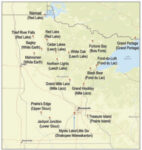
Tribal fee-to-trust issues will be defined in the next year by how tribes respond to challenges both fundamental and mundane. The Supreme Court decision in Carcieri v. Salazar will take center stage until the matter is resolved or trumped. Other recent and lingering matters hinder or facilitate tribes seeking trust acquisition, including the recently issued Opinion of the Solicitor regarding restricted fee lands and gaming, the viability of the January 3, 2008 guidance memorandum, Bureau of Indian Affairs elimination of trust acquisition performance standards, and potential fee-to-trust regulations.
Seminal Supreme Court Case
The Supreme Court issued its opinion in Carcieri v. Salazar on February 24. By press time, the Senate and House may have held hearings on the matter, and perhaps a fix will be in development.
The Supreme Court held the wording of the Indian Reorganization Act of 1934 (IRA) limited the secretary of the interior’s trust acquisition authority to tribes that were under federal jurisdiction as of the act’s enactment.
The court substantiated this holding through a strict interpretation of the act’s use of “now under federal jurisdiction” and the legislative intent to stem the loss of land sustained by tribes under the General Allotment Act. The court concluded section 2202 of the Indian Land Consolidation Act ensured tribes that were under federal jurisdiction in 1934, but opted out of the IRA, could still benefit from the trust acquisition provisions of the IRA.
The majority opinion, concurring opinions and dissenting opinions offer no clear application of this holding. Yet to be determined is the meaning of “under federal jurisdiction.” Carcieri will spawn additional questions if a congressional fix is not imminent. For example, Justice Stephen Breyer noted in his concurring opinion that the Department of the Interior, concurrent with the passage of the IRA, compiled a list of tribes it believed were subject to the IRA. None of the justices concede the list is conclusive evidence the federal government exercised jurisdiction with respect to only those tribes. In fact, Justice Breyer noted the department wrongly omitted tribes from the list. He asserted further that specific historical instances illustrate a pre-1934 jurisdiction over a tribe even though the recognition occurred after 1934. Justice Breyer listed three factors that may indicate a tribe was under federal jurisdiction in 1934: 1) a treaty with the United States still in effect in 1934, 2) a pre-1934 congressional appropriation, or 3) enrollment with the Indian Office in or before 1934.
The court’s lack of guidance will impact the trust acquisition process for some tribes until the Department of the Interior and Department of Justice weigh the ramifications of Carcieri and determine the proper administrative responses, or the federal courts build upon this holding in forthcoming cases. Congress may fill the void with a legislative fix. As noted, the Senate and House will hold hearings in the beginning of April. While this issue will be a critical matter for all tribal leaders, this will surely be a topic of great interest for cities, counties and states, as well as opponents of tribal sovereignty. Tribal leaders must carefully assess the goals and strategies associated with a potential legislative fix.
Solicitor’s Opinion
The Solicitor of the Department of the Interior concluded, in a January 18 M-Opinion, that section 2719 of the Indian Gaming Regulatory Act does not apply to land held in restricted fee. From 2002 until the issuance of this opinion the department applied the section 2719 prohibitions to lands held in restricted fee to foreclose a perceived loophole that might allow tribes to game on land acquired after IGRA’s enactment date. Secretary Gale Norton sought to prevent this circumvention of IGRA. She reasoned Congress intended not to limit the restriction to only per se trust acquisitions, but to all after-acquired land, including restricted fee land. The January 18 solicitor’s opinion limited this expansive interpretation by applying section 2719 to lands that were taken into trust pursuant to the IRA.
The solicitor stated that Secretary Norton’s concerns about a loophole were based on an assumption that off-reservation lands acquired by tribes after IGRA’s enactment would be subject to an automatic restriction on alienation imposed by the Non-Intercourse Act. The department has since determined this act applies only to “Indian Country” and lands outside of the reservation do not automatically qualify as Indian Country. On January 20, the National Indian Gaming Commission followed this rationale when it released its opinion on the Seneca Nation’s Class II gaming ordinance. It reiterated IGRA section 2719 cannot apply to land held in restricted fee and the Non-Intercourse Act does not apply to off-reservation fee land.
The solicitor and NIGC opinions have little impact on the off-reservation gaming issue, especially after City of Sherrill v. Oneida Indian Nation, which stated that the IRA provides the process for a tribe to reestablish sovereignty over land. However, its import may be in the unequivocal statement that the Non-Intercourse Act’s restrictions against alienation do not automatically attach to off-reservation parcels acquired by a tribe in fee simple absolute. Certain tribes have been forced by title companies to seek an approval from Congress prior to selling off-reservation fee land. These opinions should end this arduous and unnecessary step.
Land-Into-Trust for Gaming
On January 3, 2008, the Department of the Interior issued its memorandum entitled “Guidance on Taking Off-Reservation Land into Trust for Gaming Purposes.” The memorandum elaborated on departmental considerations when weighing the mandates of 25 C.F.R. section 151.11(b). This regulation mandates that the secretary, when contemplating an off-reservation acquisition, “shall give greater scrutiny to the tribe’s justification of anticipated benefits from the acquisition” as the distance between the proposed land acquisition and reservation increases.
The memorandum directed the reviewers to scrutinize two economic benefits to tribes: the income stream from a casino and the job training/employment benefits. It stated that “no application to take land into trust beyond a commutable distance from the reservation should be granted” unless the application analyzes and demonstrates how the negative impacts on the reservation are outweighed by the financial benefits of the gaming facility.
The new administration will soon have the opportunity to weigh in on this issue. The St. Croix Chippewa Indians of Wisconsin challenged, in April 2008, the validity of this memorandum and other actions taken by the department regarding its off-reservation gaming application. Since that time, the Tribe lost its challenge in the district court and its off-reservation fee-to-trust application was denied.
However, the U.S. Court of Appeals for the District of Columbia recently denied the U.S. government’s motion to dismiss and ordered the federal government to file a brief in response to the issues raised in the tribe’s appeal. In short, the Department of the Interior will be forced to either defend issuance of the guidance memorandum or to withdraw it and review these issues again.
No matter the outcome of this case, any tribe seeking to establish an off-reservation gaming operation still must meet the mandates of the 25 C.F.R. section 151.11. Tribes should develop applications that preemptively and conclusively address the greater scrutiny standard of the regulations.
Elimination of Trust Performance Standards
While more mundane than Supreme Court decisions and solicitor opinions, the BIA director’s elimination of performance standards for regional directors related to acquisition of tribal land into trust will have a profound impact on tribal attempts to take land, both on and off reservation, into trust. In fiscal year 2008, the BIA director inserted into the performance standards of the regional directors goals for the acquisition of land into trust in each region. This prioritized the review and determination of fee-to-trust applications by the regional offices over other tasks within these offices. This yielded determinations on hundreds of applications and the acquisition into trust of over 50,000 acres through the 25 C.F.R. section 151 process in one year.
The subordination of the land into trust issue by the BIA central office signals that tribal applications for land into trust will be forced to compete for time and money with other important programs.
These other programs may not yield the same impact on sovereignty and jurisdiction for the tribes. If tribal leaders want to re-establish this as a priority within their regions, they must emphasize the importance of this issue with the incoming assistant secretary of Indian affairs and the director of the BIA. Performance standards development begins in April of every year and culminates in early September.
Amendment of the Fee-to-Trust Regulations
A perennial fee-to-trust issue is the deliberation and promulgation of new fee-to-trust regulations. This will be on the horizon for consideration again. I think a few issues will influence this rulemaking process. First, tribal leaders will gauge the impact of the Carcieri case and its potential subsequent legislative fix. The legislative consideration of this matter may prove to be a coalescing event and training ground for all conceivable stakeholders in the fee-to-trust process, from disparate tribal opinions to regional interests to express opponents of tribal sovereignty and jurisdiction. Depending on the outcome of the legislative process, tribal leaders may urge the department to postpone reconsideration of the regulations, especially if the administrative process expands the initial consultation process beyond tribal concerns.
Second, the recently issued fee-to-trust handbook may forestall reconsideration. This handbook promulgates homogeneous fee-to-trust process throughout the nation. The BIA will hold its first tribal leaders dialogue meeting on the handbook in April. The current version purposefully omits off-reservation discretionary trust acquisitions and mandatory trust acquisitions sections. This will allow tribal leaders to participate in the development of these sections and refinement of the on-reservation acquisition portion.
Even if the fee-to-trust regulations are not considered this year, determining the impact of the Carcieri case, anticipating the outcome of the St. Croix challenge to the January 3 Guidance Memorandum, and working with the BIA to continue its laudable prior performance regarding the fee-to-trust matters should prove to be a full-time job for all those interested in the trust acquisition process, both on and off reservation.









